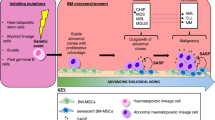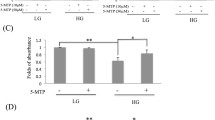Abstract
Previous studies suggested that the senescence of bone marrow mesenchymal stem cells (BM-MSCs) played an important role in the pathological process of systemic lupus erythematosus (SLE). However, the molecular mechanisms that govern this phenomenon have not been fully elucidated. Recent studies reported the activation of endoplasmic reticulum stress (ERS) participated in the growth arrest in G1 phase of cell cycle. In this study, we aimed to investigate whether ERS would induce the senescence of BM-MSCs from SLE patients. We found that there was increased expression of Glucose Regulated Protein 78 (GRP 78) in BM-MSCs from SLE patients, which indicated the activation of ERS in BM-MSCs from SLE patients. Accumulation of p27 was also found in BM-MSCs from SLE patients. Interestingly, as a chemical chaperone helping the correct folding of proteins, 4-phenylbutyric acid (4-PBA) partly rescued the senescence of BM-MSCs from SLE patients and alleviated the level of p27. These results implicated ERS-mediated senescence as a critical determinant of BM-MSCs from SLE patients.




Similar content being viewed by others
Abbreviations
- 4-PBA:
-
4-phenylbutyric acid
- ATF6:
-
Activating transcription factor-6
- BM-MSCs:
-
Bone marrow mesenchymal stem cells
- BM-MSCT:
-
Bone marrow MSC transplantation
- ER:
-
Endoplasmic reticulum
- ERS:
-
Endoplasmic reticulum stress
- FBS:
-
Fetal bovine serum
- FITC:
-
Fluorescein isothiocyanate
- GRP 78:
-
Glucose regulated protein 78
- IRE-1:
-
Inositol-requiring enzyme 1
- L-DMEM:
-
Low-glucose Dulbecco’s Modified Eagle’s Medium
- MSCT:
-
Mesenchymal stem cells transplantation
- PBS:
-
Phosphate-buffered saline
- PERK:
-
Phosphorylated PKR-like ER kinase
- PFA:
-
Paraformaldehyde
- PVDF:
-
Polyvinylidenedifluoride
- SA-β-gal:
-
Senescence-associated β-galactosidase
- SLE:
-
Systemic lupus erythematosus
- SLEDAI:
-
Systemic lupus erythematosus disease activity index
- UPR:
-
Unfolded protein response
References
Aoki K, Kakizaki F, Sakashita H, Manabe T, Aoki M, Taketo MM (2011) Suppression of colonic polyposis by homeoprotein CDX2 through its nontranscriptional function that stabilizes p27Kip1. Cancer Res 71(2):593–602
Ayala P, Montenegro J, Vivar R, Letelier A, Urroz PA, Copaja M, Pivet D, Humeres C, Troncoso R, Vicencio JM, Lavandero S, Diaz-Araya G (2012) Attenuation of endoplasmic reticulum stress using the chemical chaperone 4-phenylbutyric acid prevents cardiac fibrosis induced by isoproterenol. Exp Mol Pathol 92:97–104
Brewer JW, Diehl JA (2000) PERK mediates cell-cycle exit during the mammalian unfolded protein response. Proc Natl Acad Sci U S A 97:12625–12630
Brewer JW, Hendershot LM, Sherr CJ, Diehl JA (1999) Mammalian unfolded protein response inhibits cyclin D1 translation and cell-cycle progression. Proc Natl Acad Sci U S A 96:8505–8510
Carrano AC, Eytan E, Hershko A, Pagano M (1999) SKP2 is required for ubiquitin-mediated degradation of the CDK inhibitor p27. Nat Cell Biol 1:193–199
Carrano AC, Pagano M (2001) Role of the F-box protein Skp2 in adhesion-dependent cell cycle progression. J Cell Biol 153:1381–1390
Carrion F, Nova E, Ruiz C, Diaz F, Inostroza C, Rojo D, Monckeberg G, Figueroa FE (2010) Autologous mesenchymal stem cell treatment increased T regulatory cells with no effect on disease activity in two systemic lupus erythematosus patients. Lupus 19:317–322
Chakrabarti A, Chen AW, Varner JD (2011) A review of the mammalian unfolded protein response. Biotechnol Bioeng 108:2777–2793
Gu F, Molano I, Ruiz P, Sun L, Gilkeson GS (2012a) Differential effect of allogeneic versus syngeneic mesenchymal stem cell transplantation in MRL/lpr and (NZB/NZW)F1 mice. Clin Immunol 145:142–152
Gu Z, Akiyama K, Ma X, Zhang H, Feng X, Yao G, Hou Y, Lu L, Gilkeson GS, Silver RM, Zeng X, Shi S, Sun L (2010) Transplantation of umbilical cord mesenchymal stem cells alleviates lupus nephritis in MRL/lpr mice. Lupus 19:1502–1514
Gu Z, Cao X, Jiang J, Li L, Da Z, Liu H, Cheng C (2012b) Upregulation of p16INK4A promotes cellular senescence of bone marrow-derived mesenchymal stem cells from systemic lupus erythematosus patients. Cell Signal 24:2307–2314
Gu Z, Jiang J, Tan W, Xia Y, Cao H, Meng Y, Da Z, Liu H, Cheng C (2013a) p53/p21 Pathway involved in mediating cellular senescence of bone marrow-derived mesenchymal stem cells from systemic lupus erythematosus patients. Clin Dev Immunol 2013:134243
Gu Z, Jiang J, Xia Y, Yue X, Yan M, Tao T, Cao X, Da Z, Liu H, Miao Y, Li L, Wang Z (2013b) p21 is associated with the proliferation and apoptosis of bone marrow-derived mesenchymal stem cells from non-obese diabetic mice. Exp Clin Endocrinol Diabetes 121:607–613
Gu Z, Tan W, Feng G, Meng Y, Shen B, Liu H, Cheng C (2014) Wnt/beta-catenin signaling mediates the senescence of bone marrow-mesenchymal stem cells from systemic lupus erythematosus patients through the p53/p21 pathway. Mol Cell Biochem 387:27–37
Han C, Jin L, Mei Y, Wu M (2013) Endoplasmic reticulum stress inhibits cell cycle progression via induction of p27 in melanoma cells. Cell Signal 25:144–149
Harding HP, Calfon M, Urano F, Novoa I, Ron D (2002) Transcriptional and translational control in the Mammalian unfolded protein response. Annu Rev Cell Dev Biol 18:575–599
Hattori T, Isobe T, Abe K, Kikuchi H, Kitagawa K, Oda T, Uchida C, Kitagawa M (2007) Pirh2 promotes ubiquitin-dependent degradation of the cyclin-dependent kinase inhibitor p27Kip1. Cancer Res 67:10789–10795
Hirabayashi Y, Oka Y, Ikeda T, Fujii H, Ishii T, Sasaki T, Harigae H (2010) The endoplasmic reticulum stress-inducible protein, Herp, is a potential triggering antigen for anti-DNA response. J Immunol 184:3276–3283
Hochberg MC (1997) Updating the american college of rheumatology revised criteria for the classification of systemic lupus erythematosus. Arthritis Rheum 40:1725
Liang J, Zhang H, Hua B, Wang H, Lu L, Shi S, Hou Y, Zeng X, Gilkeson GS, Sun L (2010) Allogenic mesenchymal stem cells transplantation in refractory systemic lupus erythematosus: a pilot clinical study. Ann Rheum Dis 69:1423–1429
Lin JH, Walter P, Yen TS (2008) Endoplasmic reticulum stress in disease pathogenesis. Annu Rev Pathol 3:399–425
Liu SP, Li XY, Li Z, He LN, Xiao Y, Yan K, Zhou ZG (2012) Octanoylated Ghrelin inhibits the activation of the palmitic acid-induced TLR4/NF-kappaB signaling pathway in THP-1 macrophages. ISRN Endocrinol 2012:237613
Makino Y, Yamaza H, Akiyama K, Ma L, Hoshino Y, Nonaka K, Terada Y, Kukita T, Shi S, Yamaza T (2013) Immune therapeutic potential of stem cells from human supernumerary teeth. J Dent Res 92:609–615
Mineta H, Miura K, Suzuki I, Takebayashi S, Misawa K, Ueda Y, Ichimura K (1999) p27 expression correlates with prognosis in patients with hypopharyngeal cancer. Anticancer Res 19:4407–4412
Nie Y, Lau C, Lie A, Chan G, Mok M (2010) Defective phenotype of mesenchymal stem cells in patients with systemic lupus erythematosus. Lupus 19:850–859
Qin L, Wang Z, Tao L, Wang Y (2010) ER stress negatively regulates AKT/TSC/mTOR pathway to enhance autophagy. Autophagy 6:239–247
Schroder M, Kaufman RJ (2005) The mammalian unfolded protein response. Annu Rev Biochem 74:739–789
Scriven P, Brown NJ, Pockley AG, Wyld L (2007) The unfolded protein response and cancer: a brighter future unfolding? J Mol Med 85:331–341
Shen B, Tan W, Feng G, He Y, Liu J, Chen W, Huang X, Da Z, Xu X, Liu H, Gu Z (2013) The correlations of disease activity, socioeconomic status, quality of life, and depression/anxiety in Chinese patients with systemic lupus erythematosus. Clin Dev Immunol 2013:270878
Sheng R, Liu XQ, Zhang LS, Gao B, Han R, Wu YQ, Zhang XY, Qin ZH (2012) Autophagy regulates endoplasmic reticulum stress in ischemic preconditioning. Autophagy 8:310–325
Toyoshima H, Hunter T (1994) p27, a novel inhibitor of G1 cyclin-Cdk protein kinase activity, is related to p21. Cell 78:67–74
Yam CH, Ng RW, Siu WY, Lau AW, Poon RY (1999) Regulation of cyclin A-Cdk2 by SCF component Skp1 and F-box protein Skp2. Mol Cell Biol 19:635–645
Yoshida H, Okada T, Haze K, Yanagi H, Yura T, Negishi M, Mori K (2001) Endoplasmic reticulum stress-induced formation of transcription factor complex ERSF including NF-Y (CBF) and activating transcription factors 6alpha and 6beta that activates the mammalian unfolded protein response. Mol Cell Biol 21:1239–1248
Acknowledgments
This study was supported by grants from the Chinese National Natural Science Foundation (Nos. 81172841 81202368 and 81471603); China Postdoctoral Science Foundation (2013 M541708); the project of “333 Natural Science Foundation” of Jiangsu Grant (BRA2013286); the “Top Six Types of Talents” Financial Assistance of Jiangsu Province Grant (No. 6); the project of Jiangsu Provincial Health Department (Z201005); the innovative project of Nantong University postgraduate students (13025043); and the Jiangsu province’s Outstanding Medical Academic Leader Program (LJ201136).
Conflicts of interest
There are no commercial affiliations or conflict of interests to disclose.
Author information
Authors and Affiliations
Corresponding authors
Additional information
Zhifeng Gu and Yan Meng have contributed equally to this work.
Electronic supplementary material
Below is the link to the electronic supplementary material.
Supplementary figure
UPR cause senescence in BM-MSCs from normal patients. Normal cells were treated with 3 μM Tunicamycin (TM) for 24h. a–c Tunicamycin increased SA-β-gal-positive cell number. (Bar represents mean ± SD, n = 12, *P < 0.05 compared with the normal group). d, e The percentage of cells in G1 phase was also increased. (TIFF 3350 kb)
Rights and permissions
About this article
Cite this article
Gu, Z., Meng, Y., Tao, T. et al. Endoplasmic reticulum stress participates in the progress of senescence of bone marrow-derived mesenchymal stem cells in patients with systemic lupus erythematosus. Cell Tissue Res 361, 497–508 (2015). https://doi.org/10.1007/s00441-015-2131-x
Received:
Accepted:
Published:
Issue Date:
DOI: https://doi.org/10.1007/s00441-015-2131-x




